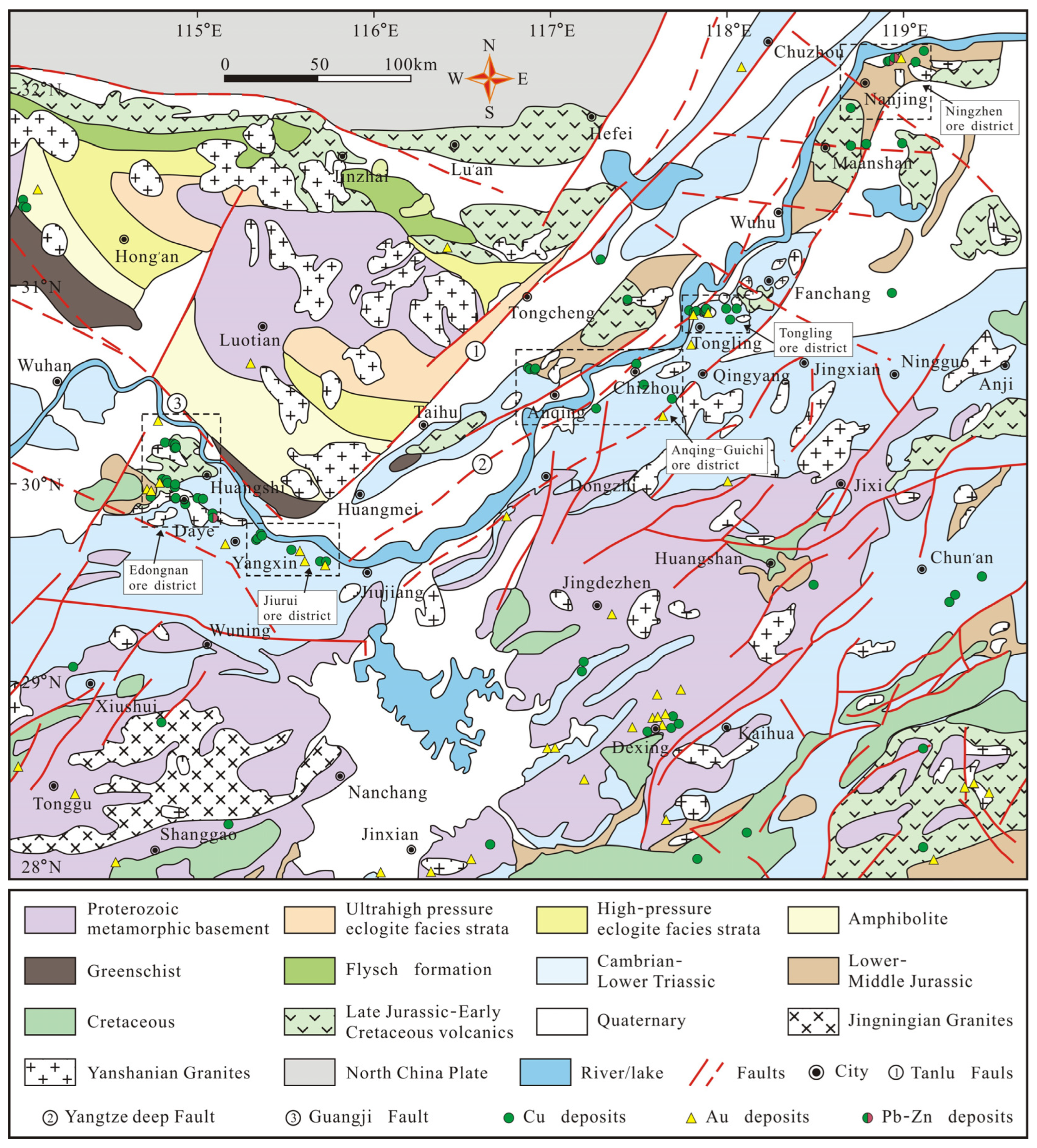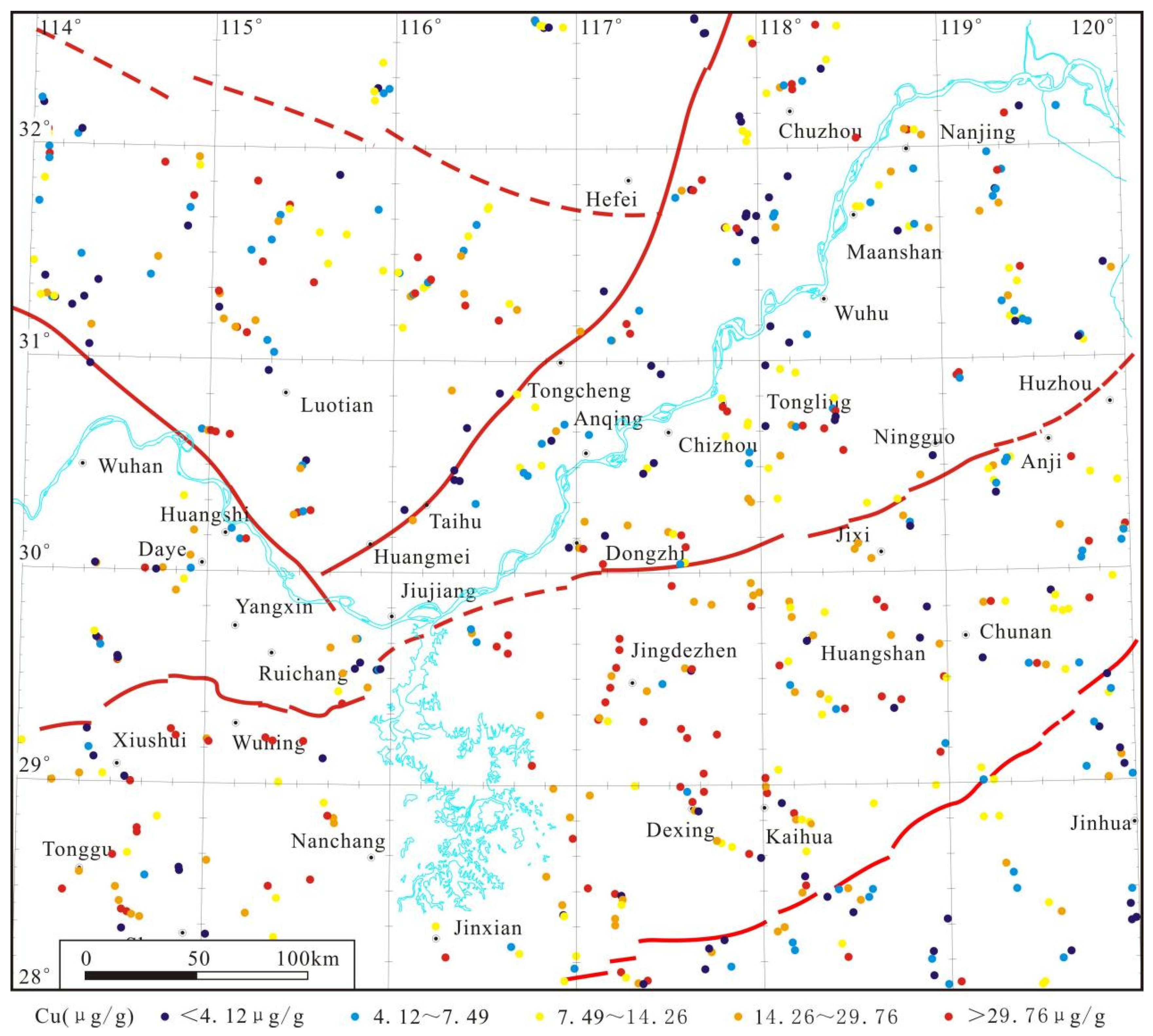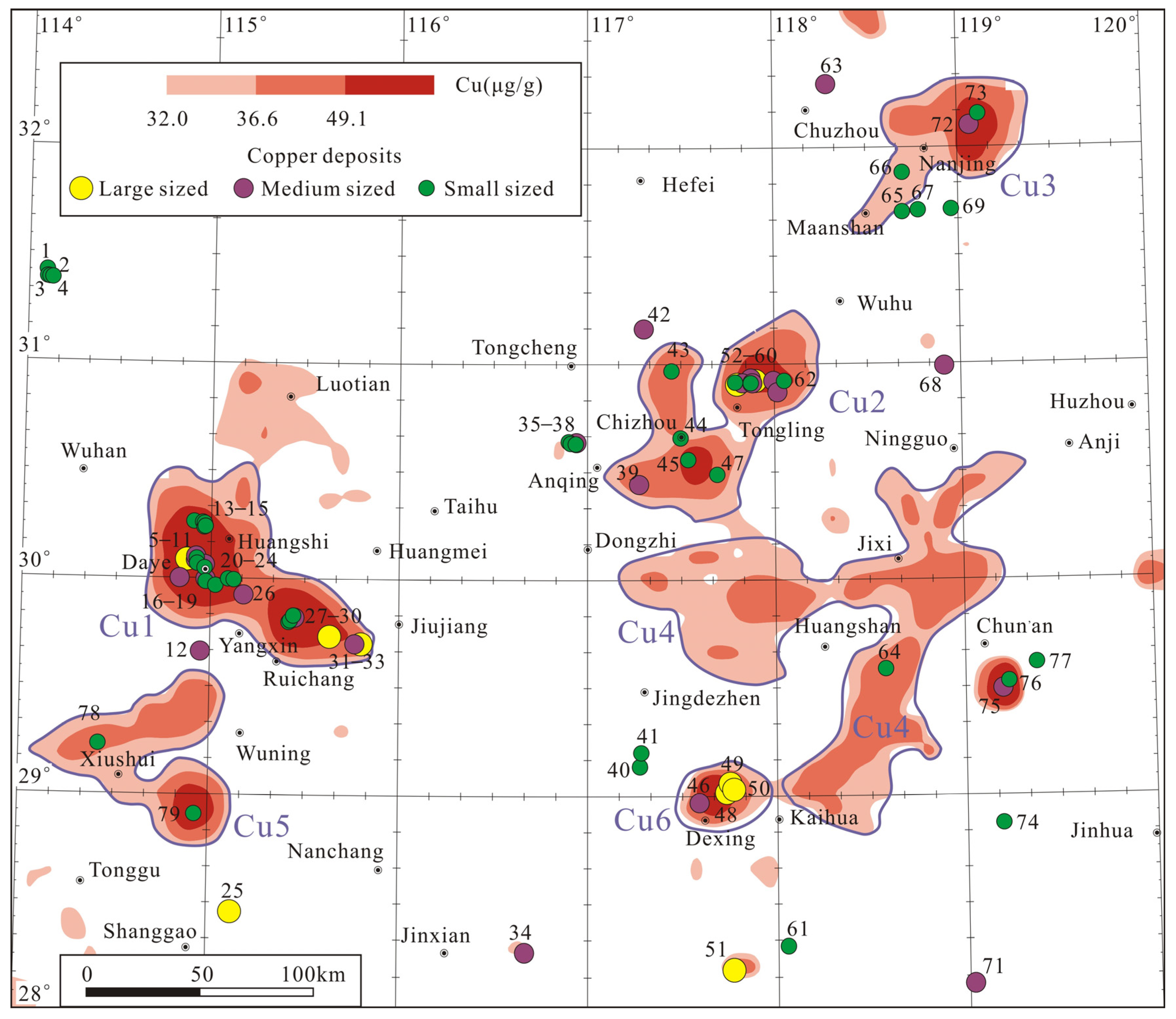The Delineation of Copper Geochemical Blocks and the Identification of Ore-Related Anomalies Using Singularity Analysis of Stream Sediment Geochemical Data in the Middle and Lower Reaches of the Yangtze River and Its Adjacent Areas, China
Abstract
:1. Introduction
2. Geological Setting
3. Data and Methods
3.1. Stream Sediment and Rock Geochemical Data
3.2. Geochemical Block of Cu
3.3. Local Singularity Mapping Method
4. Results
4.1. Statistical Characteristics of Cu
4.2. Copper Geochemical Blocks
4.3. Singularity Analysis
5. Discussion
6. Conclusions
- (1)
- All Cu ore districts and a majority of large-scale Cu deposits in the study area are located in the copper geochemical blocks. Geochemical blocks delineated with low-density geochemical data of one composite value at each grid cell of 10 km by 10 km can effectively track the locations of ore districts or large ore deposits.
- (2)
- The singularity mapping method can effectively reduce the areas of anomalies and locate the deposits, especially the large-sized ore deposits, by high-density geochemical data (4 × 4 km).
- (3)
- The combination of geochemical blocks and the local singularity mapping method can delineate the anomalous areas with potential for mineral exploration and can bring out even better results in metallogenic prediction.
Author Contributions
Funding
Data Availability Statement
Acknowledgments
Conflicts of Interest
References
- Wang, X.; Xie, X.; Cheng, Z.; Liu, D. Delineation of regional geochemical anomalies penetrating through thick cover in concealed terrains—A case history from the Olympic Dam deposit, Australia. J. Geochem. Explor. 1999, 66, 85–97. [Google Scholar] [CrossRef]
- Wang, X. Exploration geochemistry for giant ore deposits or world-class camps in concealed terrains. Miner. Depos. 2000, 19, 76–87, (In Chinese with English Abstract). [Google Scholar]
- Wang, X. Delineation of geochemical blocks for undiscovered large ore deposits using deep-penetrating methods in alluvial terrains of eastern China. J. Geochem. Explor. 2003, 77, 15–24. [Google Scholar] [CrossRef]
- Cheng, Q. A New Model for Quantifying Anisotropic Scale Invariance and for Decomposition of Mixing Patterns. J. Int. Assoc. Math. Geol. 2004, 36, 345–360. [Google Scholar] [CrossRef]
- Cheng, Q. Multifactal distribution of Eigenvalue and Eigenvectors from 2D multiplicative cascade multifractal fields. Math. Geol. 2005, 37, 915–927. [Google Scholar] [CrossRef]
- Wang, X. China geochemical baselines: Sampling methodology. J. Geochem. Explor. 2015, 148, 25–39. [Google Scholar] [CrossRef]
- Wang, X.; Xu, S.; Chi, Q.; Liu, X. Gold geochemical provinces in China: A micro- and nano-scale formation mechanism. Acta Geol. Sin. 2013, 87, 1–8, (In Chinese with English Abstract). [Google Scholar]
- Wang, X.; Shen, W.; Zhang, B.; Nie, L.; Chi, Q.; Xu, S. Relationship of Geochemical Blocks and Ore Districts: Examples from the Eastern Tianshan Metallogenic Belt, Xinjiang, China. Earth Sci. Front. 2007, 14, 116–120. [Google Scholar] [CrossRef]
- Xie, X.; Liu, D.; Xiang, Y.; Yan, G. Geochemical blocks—Development of concept and methodology. Geol. China 2002, 29, 225–233, (In Chinese with English Abstract). [Google Scholar]
- Xie, X. Surficial and Superimposed Geochemical Exploration for Giant Ore Deposits; Clark, A.H., Ed.; Giant Ore Deposits II; Queen’s University Press: Kingston, ON, Canada, 1995; pp. 475–485. [Google Scholar]
- Liu, D. Development and significance of geochemical blocks. Geochimica 2002, 31, 539–548, (In Chinese with English Abstract). [Google Scholar]
- Cheng, Q. Non-linear mineralization model and information processing methods for prediction of unconventional mineral resources. J. Earth Sci. 2003, 28, 1–10. [Google Scholar]
- Cheng, Q. Non-Linear Theory and Power-Law Models for Information Integration and Mineral Resources Quantitative Assessments. Math. Geosci. 2008, 40, 503–532. [Google Scholar] [CrossRef]
- Zhao, P.; Hu, W.; Li, Z. Statistical Prediction for Mineral Deposits, 2nd ed.; Geological Publishing House: Beijing, China, 1994; pp. 113–118. (In Chinese) [Google Scholar]
- Zuo, R.; Wang, J. Fractal/multifractal modeling of geochemical data: A review. J. Geochem. Explor. 2016, 164, 33–41. [Google Scholar] [CrossRef]
- Zuo, R.; Carranza, E.J.M.; Wang, J. Spatial analysis and visualization of exploration geochemical data. Earth-Sci. Rev. 2016, 158, 9–18. [Google Scholar] [CrossRef]
- Cheng, Q.; Agterberg, F.; Ballantyne, S. The separation of geochemical anomalies from background by fractal methods. J. Geochem. Explor. 1994, 51, 109–130. [Google Scholar] [CrossRef]
- Deng, J.; Wang, Q.; Wan, L.; Liu, H.; Yang, L.; Zhang, J. A multifractal analysis of mineralization characteristics of the Dayingezhuang disseminated-veinlet gold deposit in the Jiaodong gold province of China. Ore Geol. Rev. 2011, 40, 54–64. [Google Scholar] [CrossRef]
- Wang, Q.; Deng, J.; Zhao, J.; Li, N.; Wan, L. The fractal relationship between orebody tonnage and thickness. J. Geochem. Explor. 2012, 122, 4–8. [Google Scholar] [CrossRef]
- Agterberg, F.; Cheng, Q.; Brown, A.; Good, D. Multifractal modeling of fractures in the Lac du Bonnet Batholith, Manitoba. Comput. Geosci. 1996, 22, 497–507. [Google Scholar] [CrossRef]
- Carranza, E.J.M. Controls on mineral deposit occurrence inferred from analysis of their spatial pattern and spatial association with geological features. Ore Geol. Rev. 2009, 35, 383–400. [Google Scholar] [CrossRef]
- Wan, L.; Wang, Q.; Deng, J.; Gong, Q.; Yang, L.; Liu, H. Identification of Mineral Intensity along Drifts in the Dayingezhuang Deposit, Jiaodong Gold Province, China. Resour. Geol. 2010, 60, 98–108. [Google Scholar] [CrossRef]
- Afzal, P.; Alghalandis, Y.F.; Khakzad, A.; Moarefvand, P.; Omran, N.R. Delineation of mineralization zones in porphyry Cu deposits by fractal concentration–volume modeling. J. Geochem. Explor. 2011, 108, 220–232. [Google Scholar] [CrossRef]
- Li, C.; Ma, T.; Shi, J. Application of a fractal method relating concentrations and distances for separation of geochemical anomalies from background. J. Geochem. Explor. 2003, 77, 167–175. [Google Scholar] [CrossRef]
- Cheng, Q. GeoData Analysis System (GeoDAS) for Mineral Exploration: User’s Guide and Exercise Manual. Material for the Training Workshop on GeoDAS Held at York University, Toronto, Canada. 2000, Volume 1–3, p. 204. Available online: http://www.gisworld.org/geodas (accessed on 14 August 2023).
- Cheng, Q. Mapping singularities with stream sediment geochemical data for prediction of undiscovered mineral deposits in Gejiu, Yunnan Province, China. Ore Geol. Rev. 2007, 32, 314–324. [Google Scholar] [CrossRef]
- Cheng, Q.; Agterberg, F.P. Singularity of mineralization processes and power-law models for mineral resources quantitative assessments. J. China Univ. Geosci. 2007, 18, 245–247, (In Chinese with English Abstract). [Google Scholar]
- Zuo, R.; Cheng, Q. Mapping singularities—A technique to identify potential Cu mineral deposits using sediment geochemical data, an example for Tibet, West China. Mineral. Mag. 2008, 72, 531–534. [Google Scholar] [CrossRef]
- Zuo, R.; Cheng, Q.; Agterberg, F.; Xia, Q. Application of singularity mapping technique to identify local anomalies using stream sediment geochemical data, a case study from Gangdese, Tibet, western China. J. Geochem. Explor. 2009, 101, 225–235. [Google Scholar] [CrossRef]
- Zuo, R.; Xia, Q.; Zhang, D. A comparison study of the C–A and S–A models with singularity analysis to identify geochemical anomalies in covered areas. Appl. Geochem. 2013, 33, 165–172. [Google Scholar] [CrossRef]
- Bai, J.; Porwal, A.; Hart, C.; Ford, A.; Yu, L. Mapping geochemical singularity using multifractal analysis: Application to anomaly definition on stream sediments data from Funin Sheet, Yunnan, China. J. Geochem. Explor. 2010, 104, 1–11. [Google Scholar] [CrossRef]
- Xiao, F.; Chen, J.; Zhang, Z.; Wang, C.; Wu, G.; Agterberg, F.P. Singularity mapping and spatially weighted principal component analysis to identify geochemical anomalies associated with Ag and Pb-Zn polymetallic mineralization in Northwest Zhejiang, China. J. Geochem. Explor. 2012, 122, 90–100. [Google Scholar] [CrossRef]
- Lu, Q.; Yang, Z.; Yan, J.; Xu, W. The metallogenic potential, prospecting idea and primary attempt in depth of the ore belt of the Middle and Lower Reach of the Yangtze River—A case study of Tongling ore district. Acta Geol. Sin. 2007, 81, 865–881, (In Chinese with English Abstract). [Google Scholar]
- Chang, Y.; Liu, X.; Wu, Y. Metallogenic Belt of the Middle and Lower Yangtze River; Geological Publishing House: Beijing, China, 1991; pp. 71–76. (In Chinese) [Google Scholar]
- Zhai, Y.; Yao, S.; Lin, X. Regularities of Metallogenesis for Copper (Gold) Deposits in the Middle–Lower Yangtze River Region Area; Geological Publishing House: Beijing, China, 1992; pp. 1–120. (In Chinese) [Google Scholar]
- Mao, J.; Holly, S.; Du, A.; Zhou, T.; Mei, Y.; Li, Y.; Zang, W.; Li, J. Molybdenite Re-Os precise dating for molybdenite from Cu-Au-Mo deposits in the Middle-Lower reaches of Yangtze River belt and its implications for mineralization. Acta Geol. Sin. 2004, 78, 121–131, (In Chinese with English Abstract). [Google Scholar]
- Zhou, T.; Fan, Y.; Yuan, F. Advances on petrogensis and metallogeny study of the mineralization belt of the Middle–Lower Yangtze River region area. Acta Petrol. Sin. 2008, 24, 1665–1678, (In Chinese with English Abstract). [Google Scholar]
- Dong, S.; Ma, L.; Liu, G.; Xue, H.; Shi, W.; Li, J. On Dynamics of metallogenic belt of Middle-Lower reaches of Yangtze River, eastern China. Acta Geol. Sin. 2011, 85, 612–625, (In Chinese with English Abstract). [Google Scholar]
- Xu, S.; Wang, X.; Zhang, B.; Nie, L.; Chi, Q. Geochemical characteristics response of different scales of data: A case study of gold element from 1:200000 regional data of Middle-Lower Reaches of the Yangtze River. Geophys. Geochem. Explor. 2012, 36, 27–32, (In Chinese with English Abstract). [Google Scholar]
- Xu, S.; Wang, W. The significance of different scale copper geochemical anomalies and large ore deposit prediction in the Middle-Lower Yangtze River. Earth Sci. Front. 2012, 19, 84–92, (In Chinese with English Abstract). [Google Scholar]
- Wang, X.; Xu, S.; Chi, Q.; Liu, X.; Wang, W. Accumulation and distribution of metallogenic elements in south China continent. Geochimica 2013, 42, 229–241, (In Chinese with English Abstract). [Google Scholar]
- Liu, B.; Wang, X. Origin of Cu Geochemical Deomains in the Middle-Lower Yangtze River Region and Its Constraints on the Formation of Cu Deposit Districts. Bull. Mineral. Petrol. Geochem. 2018, 37, 271–282, (In Chinese with English Abstract). [Google Scholar]
- Mao, J.; Shao, Y.; Xie, G.; Zhang, J.; Chen, Y. Mineral deposit model for porphyry-skarn polymetallic copper deposits in Tongling ore dense district of Middle-Lower Yangtze Valley Metallogenic belt. Miner. Depos. 2009, 28, 109–119, (In Chinese with English Abstract). [Google Scholar]
- Gao, L.; Ding, X.; Pang, W.; Zhang, C. New geological time scale of Late Precambrian in China and geochronology. Geol. China 2010, 37, 1014–1020, (In Chinese with English Abstract). [Google Scholar]
- Liu, B.; Wang, X.; Hou, Q. Temporal distribution of copper geochemical blocks in the Middle–Lower Yangtze River region: Evidence from detrital zircon LA-ICP-MS U-Pb dating. Acta Geosci. Sin. 2020, 41, 835–850, (In Chinese with English Abstract). [Google Scholar]
- Zhou, T.; Fan, Y.; Yuan, F.; Zhang, L.; Ma, L.; Qian, B.; Xie, J. Petrogensis and metallogeny study of the volcanic basins in the Middle and Lower Yangtze metallogenic belt. Acta Geol. Sin. 2011, 85, 712–730, (In Chinese with English Abstract). [Google Scholar]
- Li, H.; Ling, M.-X.; Li, C.-Y.; Zhang, H.; Ding, X.; Yang, X.-Y.; Fan, W.-M.; Li, Y.-L.; Sun, W.-D. A-type granite belts of two chemical subgroups in central eastern China: Indication of ridge subduction. Lithos 2012, 150, 26–36. [Google Scholar] [CrossRef]
- Li, J.; Zhao, X.; Zhou, M.; Vasconcelos, P.; Ma, C.; Deng, X.; Sérgio de Souza, Z.; Zhao, Y.; Wu, G. Origin of the Tongshankou porphyry-skarn Cu-Mo deposit, eastern Yangtze craton, Eastern China: Geochronological, geochemical, and Sr-Nd-Hf isotopic constraints. Miner. Depos. 2008, 43, 315–336. [Google Scholar] [CrossRef]
- Zhou, T.; Fan, Y.; Yuan, F.; Zhong, G. Progress of geological study in the Middle-Lower Yangtze River Vallley metallogenic belt. Acta Petrol. Sin. 2012, 28, 3051–3066, (In Chinese with English Abstract). [Google Scholar]
- Wang, Y.; Zhang, Q.; Wang, Y. Geochemical characteristics of volcanic rocks from Ningwu area, and its significance. Acta Petrol. Sin. 2001, 17, 565–575, (In Chinese with English Abstract). [Google Scholar]
- Xie, X.; Ma, X.; Ren, T. Geochemical mapping in China. J. Geochem. Explor. 1997, 60, 99–113. [Google Scholar]
- Doe, B.R. Source rock and the genesis of metallic mineral deposits. Glob. Tecton. Metallog. 1991, 4, 13–19. [Google Scholar] [CrossRef]
- Xie, X. Geochemical Prediction Method for Giant Ore Deposits; Xie, X., Shao, Y., Wang, X., Eds.; Exploration Geochemistry Into 21st Century; Geological Publishing House: Beijing, China, 1999; pp. 61–69. (In Chinese) [Google Scholar]
- Gao, Y.; Chen, J.; Zhang, Y.; Wang, W. Further research on geochemical mapping. Comput. Tech. Geophys. Geochem. Explor. 2015, 37, 538–546, (In Chinese with English Abstract). [Google Scholar]
- Gao, Y.; Li, J.; Chen, J.; Zhang, Y.; Wang, W. The visualization of iteration processing of geochemical exploration data and an analysis of the result. Geophys. Geochem. Explor. 2016, 40, 1021–1025, (In Chinese with English Abstract). [Google Scholar]
- Gao, Y.; Liu, Q.; Wang, W.; Wang, W. The discussing of normal distribution and long value in geochemical exploration. Comput. Tech. Geophys. Geochem. Explor. 2017, 39, 404–410, (In Chinese with English Abstract). [Google Scholar]
- Agterberg, F.P. Multifractals and geostatistics. J. Geochem. Explor. 2012, 122, 113–122. [Google Scholar] [CrossRef]






| Sample Types | Min. | Max. | Mean | Median | Standard Deviation |
|---|---|---|---|---|---|
| Mafic rocks (N) | 16.45 | 333.41 | 104.13 | 47.98 | 122.15 |
| Acid rocks (γ) | 1.07 | 156.93 | 12.89 | 7.02 | 20.32 |
| Archaean (Ar) | 1.82 | 34.74 | 16.18 | 15.70 | 10.87 |
| Proterozoic (Pt) | 1.20 | 228.93 | 24.03 | 16.94 | 26.15 |
| Cambrian (Є) | 1.33 | 102.77 | 16.46 | 10.09 | 19.43 |
| Ordovician (O) | 1.46 | 65.12 | 23.15 | 17.09 | 19.78 |
| Silurian (S) | 3.79 | 111.33 | 28.46 | 27.74 | 20.15 |
| Devonian (D) | 2.43 | 46.06 | 10.44 | 7.76 | 10.79 |
| Carboniferous (C) | 1.26 | 37.38 | 11.46 | 4.66 | 12.48 |
| Permian (P) | 1.33 | 126.83 | 18.91 | 4.72 | 29.70 |
| Triassic (T) | 1.39 | 30.73 | 7.47 | 5.12 | 6.82 |
| Jurassic (J) | 1.58 | 67.82 | 11.23 | 5.95 | 12.88 |
| Cretaceous (K) | 2.20 | 41.52 | 14.82 | 12.96 | 9.73 |
| Tertiary (R) | 4.30 | 73.84 | 15.89 | 12.27 | 16.47 |
Disclaimer/Publisher’s Note: The statements, opinions and data contained in all publications are solely those of the individual author(s) and contributor(s) and not of MDPI and/or the editor(s). MDPI and/or the editor(s) disclaim responsibility for any injury to people or property resulting from any ideas, methods, instructions or products referred to in the content. |
© 2023 by the authors. Licensee MDPI, Basel, Switzerland. This article is an open access article distributed under the terms and conditions of the Creative Commons Attribution (CC BY) license (https://creativecommons.org/licenses/by/4.0/).
Share and Cite
Liu, B.; Cui, X.; Wang, X. The Delineation of Copper Geochemical Blocks and the Identification of Ore-Related Anomalies Using Singularity Analysis of Stream Sediment Geochemical Data in the Middle and Lower Reaches of the Yangtze River and Its Adjacent Areas, China. Minerals 2023, 13, 1397. https://doi.org/10.3390/min13111397
Liu B, Cui X, Wang X. The Delineation of Copper Geochemical Blocks and the Identification of Ore-Related Anomalies Using Singularity Analysis of Stream Sediment Geochemical Data in the Middle and Lower Reaches of the Yangtze River and Its Adjacent Areas, China. Minerals. 2023; 13(11):1397. https://doi.org/10.3390/min13111397
Chicago/Turabian StyleLiu, Bin, Xingtao Cui, and Xueqiu Wang. 2023. "The Delineation of Copper Geochemical Blocks and the Identification of Ore-Related Anomalies Using Singularity Analysis of Stream Sediment Geochemical Data in the Middle and Lower Reaches of the Yangtze River and Its Adjacent Areas, China" Minerals 13, no. 11: 1397. https://doi.org/10.3390/min13111397
APA StyleLiu, B., Cui, X., & Wang, X. (2023). The Delineation of Copper Geochemical Blocks and the Identification of Ore-Related Anomalies Using Singularity Analysis of Stream Sediment Geochemical Data in the Middle and Lower Reaches of the Yangtze River and Its Adjacent Areas, China. Minerals, 13(11), 1397. https://doi.org/10.3390/min13111397





